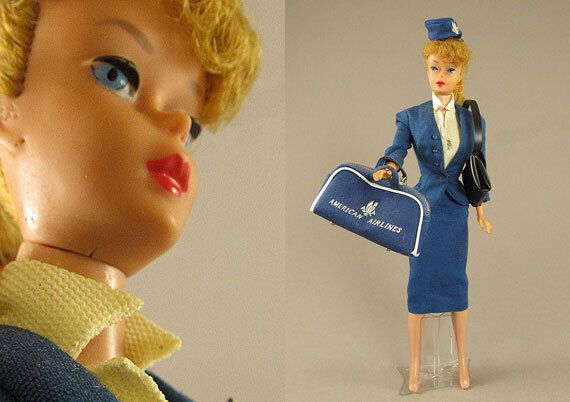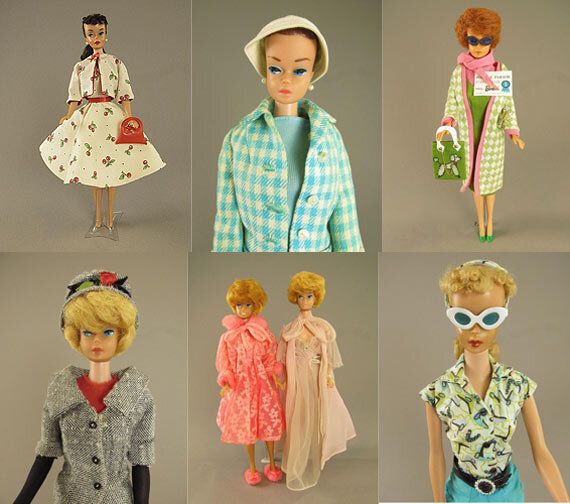Annie Burke is a dog rescuer. A divorced 58-year-old, former occupational nurse, with an 'Oh my gosh' hand to the mouth kind of mid-west American nature. She's managed to combine her professional experience in caring with a propensity for hoarding, homing, accumulating. It's abandoned dogs right now, but for much of her life it's been Barbie dolls.
She's spent a good 25 years collecting Barbies, trading them, showing them. But Annie has discerning tastes. Her focus is on the golden age of Barbies - 1959 to '72. After that "it's just blah!" she says, "play things", "no uniqueness", "they all look the same!"

American Girl Barbie with Music Centre Matinee
She started collecting properly when her mother passed away, and she rediscovered her old dolls in the attic.
"I didn't have any brothers so none of the dolls had their heads ripped off," she joked. "I then started going to doll shows."
Despite her avid embracing of all things Barbie she's about to divest herself of most of them, auctioning off the bulk of her collection, and putting the money back into the things she cares most about these days - those dogs.

The no.5 Ponytail Barbie with American Airlines outfit, circa 1961
And it's a good time to sell. With the popularity of '60s themed shows like Mad Men and Pan Am there has been a marked resurgence in interest in vintage Barbies, with their black ponytails, bright red lipstick and cocktail dresses.
The toys, one of the first mass-produced dolls based on adults, exude the particular style of the 1960s, mimicking both the fashion of the day and the confidence of an America that was throwing off the repressed airs of the '50s and undergoing a revolution of ideas. For Barbie too, they were halcyon days. After 1971 her eyes were moved to look frontwards, the design was standardised and Barbie's air of womanly independence gave way to an all-conforming drive for perfection. It led to accusations the toy had become a bad role model for young girls and promoted anorexia and an impossible BMI.
An original 'no.1' Barbie from 1959 in pristine condition can fetch as much as $5,000. That's still down from the market peak of eight years ago when some were selling for $10,000, but according to auctioneer Mark Harris there is a definite resurgence in interest.

The no.3 Barbie with factory 'up-do' and apple print dress, circa 1959
In recent years a strong buyers market has emerged in China among lucrative new money investors, although Harris insists it's a 'phase' and the core investors remain in the States, Germany, France, Japan and the United Kingdom.
The 57-year-old from Columbus, Ohio, said: "We have three large scale auctions a year of vintage Barbies. When the doll market goes down the sellers dry up because they're afraid to put them out in the market, but the Barbies are still there. They love Barbie, and they will always love Barbie.

Barbie dolls from the 1960s mimicked more closely the fashion of the day
"The '60s were the heyday of Barbie, when Mrs Handler first made the dolls in Japan. That was a very cool era in our history, after WWII when guys were coming back from war, building homes, building families. It was really popping. The cocktail generation. They were all smoking and having kids and making money."
Seen nowadays to represent a distortedly perfect idyll of teen America, over a billion Barbies have been sold in the past 53 years in 150 countries. But Barbie's origins are in post-war Europe where American businesswoman Ruth Handler first spotted a German Bild Lilli doll on a trip in 1956. The wife of Mattel co-founder Elliot, she quickly realised the potential appeal of an 'adult' doll and from it developed Barbie. In the first year of production 350,000 were made in Japan, but as their popularity grew production shifted to the U.S.

The no.5 ponytail Barbie with 'After Five' outfit
With their hand-painted eyes averted to the side, stylised black eyebrows, interchangeable wardrobe and haughty expressions they were an immediate hit with kids, who had grown tired of dolls still based on a model that had barely altered since Victorian times.
With their upturned noses and working girl hair many find them more peculiarly beautiful than the overly perfect, streamlined dolls of today.
Speaking from her home in Cleveland, Ohio, Annie said: "I guess when we were kids we were so over baby dolls. We wanted a doll that we could change outfits and dress them in what the teenagers were wearing. That's what started the interest."

A collection of shoes, belts, bags and other Babs accessories
"The current Barbies have no uniqueness. The original Barbies had different faces, which would change each year, and they were fashionable. You could dress Barbie in the same clothes Jackie Kennedy was wearing. There was so much change in the 1960s and every girl wanted a Barbie doll, they reflected the fashion of the time. People were wearing these clothes. And that style has come around again, look at the fashions today: minis, tights, '60s patterns that were last seen being modelled by Twiggy."
Harris figures Friday's auction will net about $50,000, with many buyers bidding straight from the internet.
"We're at the beginning of a resurgence of interest in these dolls," he said. "Don't ask me how I know that, it's just something I can feel in the sales room."
McMasters Harris Apple Tree Doll auction of the Annie Burke Collection takes place in Ohio on Friday.
